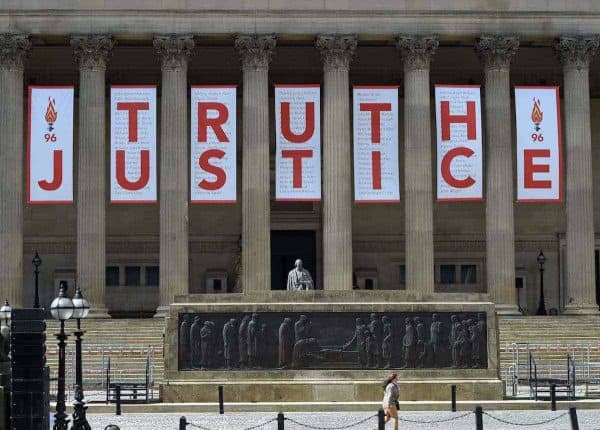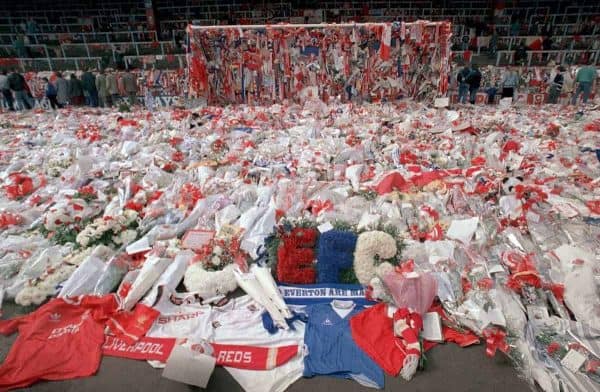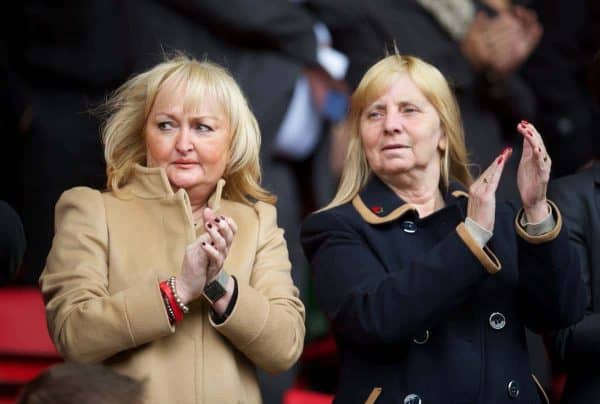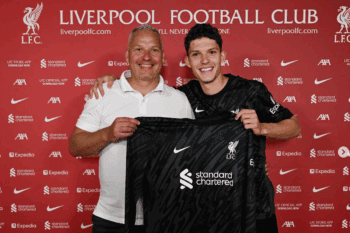The Hillsborough inquest ruled that the 96 supporters to lose their lives in 1989 were unlawfully killed, bringing justice to Merseyside.
Nine jurors ruled that the 96 were unlawfully killed, with police and ambulance workers culpable for “gross negligence” during Liverpool’s FA Cup encounter with Nottingham Forest on 15 April 1989.
Families, survivors and the rest of the footballing world celebrated a triumph of justice, over 27 years after the events of the disaster.
Here’s how the media saw Tuesday’s Hillsborough inquest verdict.

For most, justice was the prevailing word, with a 27-year wait ending with an emphatic delivery in Warrington.
Chris Bascombe of the Telegraph labelled it a “bittersweet victory” for the families and survivors, with justice coming years too late:
The city of Liverpool, bonded in grief and rage in 1989, was united in pride and validation as it received the verdicts of the Hillsborough inquests.
Hundreds gathered at the city’s St George’s Hall, hundreds of thousands across the city painstakingly monitored the response to each of the 14 key questions, relief giving way to an unburdening of 27 years of emotion.
It was the answer to question six – that of unlawful killing – that provoked most tears. You could say of joy, but a tainted happiness. There could never be a more bittersweet victory, if indeed any sense of triumph can be applied to such belated public exposure and acknowledgement of truth.
The Mirror‘s Brian Reade recalled the “heartbreaking” scene in the courtroom as the jury revealed their verdict:
Up until now there was a big lie on their graves. An epitaph that said these 96 innocents died in an accident.
Now THE TRUTH is written large. They died because those entrusted with their safety were criminally negligent.
And as the jury delivered the unlawful killing verdicts and exonerated the fans, the joy on those tear-stained faces, laced with anger that it had taken so long for the truth to come out in court, was one of the most poignant, heart-breaking scenes I’ve ever witnessed.
The Telegraph‘s Paul Hayward, delivering a thorough and sensitive unravelling of the events and the aftermath, lauded a climax of truth:
The youngest Hillsborough victim was Jon-Paul Gilhooley, aged 10. The oldest was Gerard Baron, 67. Thirty-eight were aged 19 or under. The memories of all have been trapped in a political and legal limbo that has held for 27 years. These were not random deaths. There were causes. And now there is truth. There is a reckoning.

With many of the families of the 96 present at Tuesday’s inquest, the focus switched to how their anguish turned to relief.
Reade pictured “gasps of disbelief and sobs of joy” as the verdicts were called out:
All they ever wanted was the correct words on their loved ones’ death certificates.
All these families fought for during 27 long, hard years, with every ounce of energy and love in them, and in the face of relentless kicks in the teeth, was that most basic of human rights.
And, as their gasps of disbelief and sobs of joy echoed around a specially-built Warrington court-room at the jury’s verdicts, they finally achieved it.
Former Liverpool striker John Aldridge, who was at Hillsborough on the day of the disaster, recalled to the dressing rooms as the horror played out, called Tuesday’s verdict “the biggest victory in the history of the club” in his column for the Liverpool Echo:
Today’s verdicts are a complete, and absolutely deserved, vindication for the victims, for the survivors, the families, and for Liverpool fans and the city as a whole.
This, for me, is the biggest victory in the history of the club. And it’s got nothing to do with football.

As Tuesday’s ruling laid the blame at the feet of the police and ambulance workers at Hillsborough that day, many called for a renewed pursuit of further justice.
The Guardian‘s David Conn, who was applauded by the Hillsborough families during Tuesday’s press conference, detailed the police’s continued efforts to shift blame—even yesterday:
The remnants of the police effort to blame the supporters were on show even here, despite the families’ long, exhausting battle against it, and the lord chief justice, Igor Judge, having stated when he quashed the first inquest that the narrative was false.
Duckenfield’s own barrister, John Beggs QC, an advocate instructed by police forces nationwide, pressed the case most forcefully that supporters had misbehaved, persistently introducing as context into his questioning notorious previous episodes of football hooliganism, his manner often repellent to the families attending.
But Beggs was not alone. The present-day South Yorkshire police force itself and the Police Federation also argued that Liverpool supporters outside the Leppings Lane end could be found to have contributed to the disaster because “a significant minority” were alleged to have been drunk and “non-compliant” with police orders to move back. Yet survivors gave evidence of chaos at the Leppings Lane approach, no atmosphere of drunkenness or misbehaviour, and no meaningful police activity to make orderly queueing possible in that nasty space.
Hayward suggested that the cover-up had “undermined” the country’s faith in the policing establishment:
All along, the Hillsborough tragedy undermined faith in our system of redress: in South Yorkshire police and the Westminster machine. For the Sheffield constabulary to concoct such a vile narrative to conceal their own mistakes was a slight not only on the victims but the entire British police service. The contagion of mistrust spread across policing and across our national life.
While Reade said that “the guilty need to pay” following a shocking cover-up of the events back in 1989:
It is one of the most damning indictments on this country’s justice system, which those responsible must now pay for and those in power should never be allowed to forget.
Only when we get to the bottom of the cover-up which kept the most heinous of lies going for more than a quarter of a century, the lie that the fans, not the police, caused the biggest disaster in British sporting history, will those families get any form of justice.
There can be no stone left unturned, now.
The guilty need to pay for knowingly kicking these families and survivors to hell and back, leaving a soul-numbing trail of broken marriages, suicides and deaths.

Many praised the determination and resolve of the working-class families who fought the establishment to secure Tuesday’s verdict.
Tuesday’s Guardian editorial hailed a triumph for “unfashionable virtues” and the city of Liverpool:
What a triumph these findings are for football supporters, for the city of Liverpool – and for the unfashionable virtues of solidarity, a shared identity and the strength of collective endeavour.
Reade hailed the families’ resilience, with the likes of Trevor Hicks and Margaret Aspinall enduring 27 years battling adversity:
All they ever wanted was the correct words on their loved ones’ death certificates.
All these families fought for during 27 long, hard years, with every ounce of energy and love in them, and in the face of relentless kicks in the teeth, was that most basic of human rights.
And, as their gasps of disbelief and sobs of joy echoed around a specially-built Warrington court-room at the jury’s verdicts, they finally achieved it.
And Aldridge paid tribute to a unique city, and the families’ dignity, class and “passion for what was right”:
Do you know what? A lot of cities would have crumbled in the face of that hostility, that ignorance, that opposition. Not Liverpool.
The way the families have conducted themselves throughout, with such dignity, such class, such passion for what was right – no praise is too high for those people.
I’m proud to be a Scouser. I know how we are, we fight for what’s right and what we believe in. We always have. We were never going to let this go.
“They picked on the wrong people.”
Never a truer word spoken.

While the enduring line was that this was a tragedy of negligence that can never happen again.
The Express‘ Michael Booker, detailed his account of a trip to see Leeds United take on Brighton & Hove Albion that day, portrayed the universality of the disaster:
It could have been any football fan that day. The rickety old stadiums. The fences erected to keep us all penned in.
The suspicion that all football fans were potential criminals.
A working class sport had seemingly become a nuisance, only just tolerated by the authorities and yes, some elements in the press.
[…]
The families of those 96 Liverpool fans who, like us, set out to simply watch a football match on April 15th 1989 never got to greet their loved ones again.
For it to take 27 years for those families to gain justice for that will forever be a source of national shame.
Matt Lawton of the Mail depicts the scene at Hillsborough today, and the changes that have been made since the disaster, as well as changes that still need to be made:
The tunnel has undergone an overhaul. It is no longer as steep, narrow and dark as it once was. Indeed a common misconception among many of those who walk along Leppings Lane into the tarmacked area in front of the stand is that it has been frozen in time.
Gate C has in fact gone altogether, with the whole exterior that represents the turnstile area expanded and modernised to meet safety requirements. The contrast between old and new brick is the giveaway.
Inside the stand there are other subtle but significant changes beyond a low wall with safety gates that has replaced the steel fence. Each step of the terracing was widened to accommodate seating, the roof was extended to cover the entire stand and, perhaps more crucially, there are now two stairways to link the two tiers.
Had they been there in 1989, when the stadium did not even hold a valid safety certificate, lives almost certainly would have been spared.
Meanwhile, though every other national newspaper carried the Hillsborough story on its front page on Wednesday morning, as well as many other publications from around the world, two made exception: unsurprisingly, the S*n and the Times.















